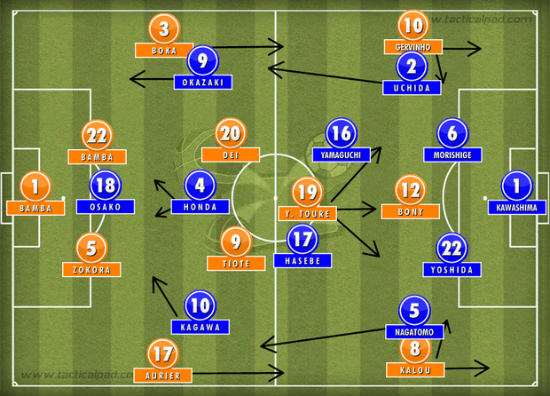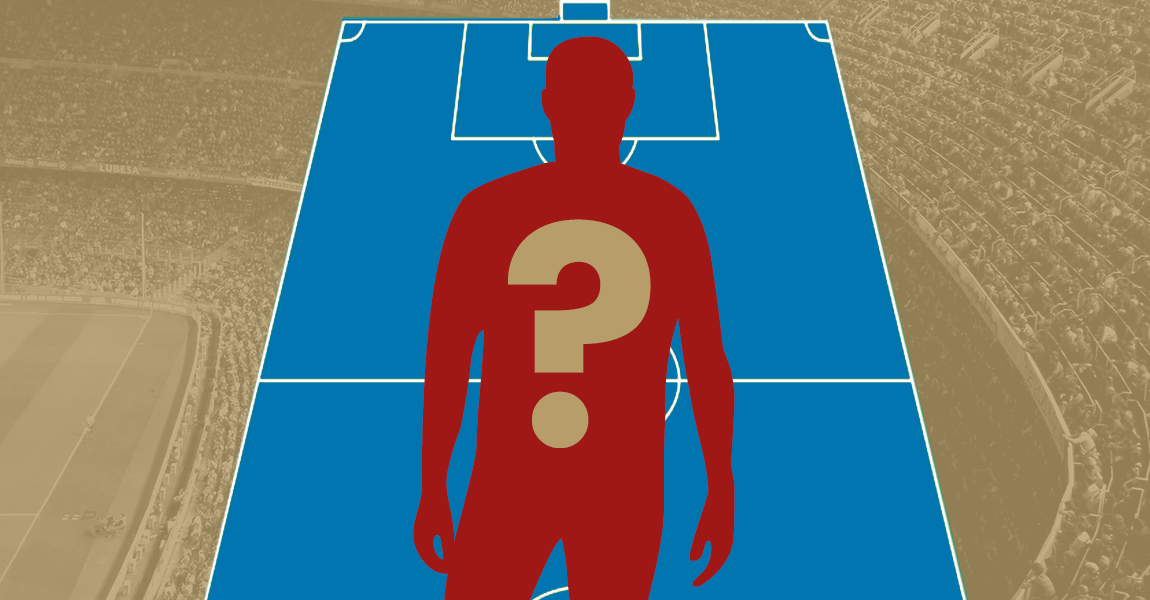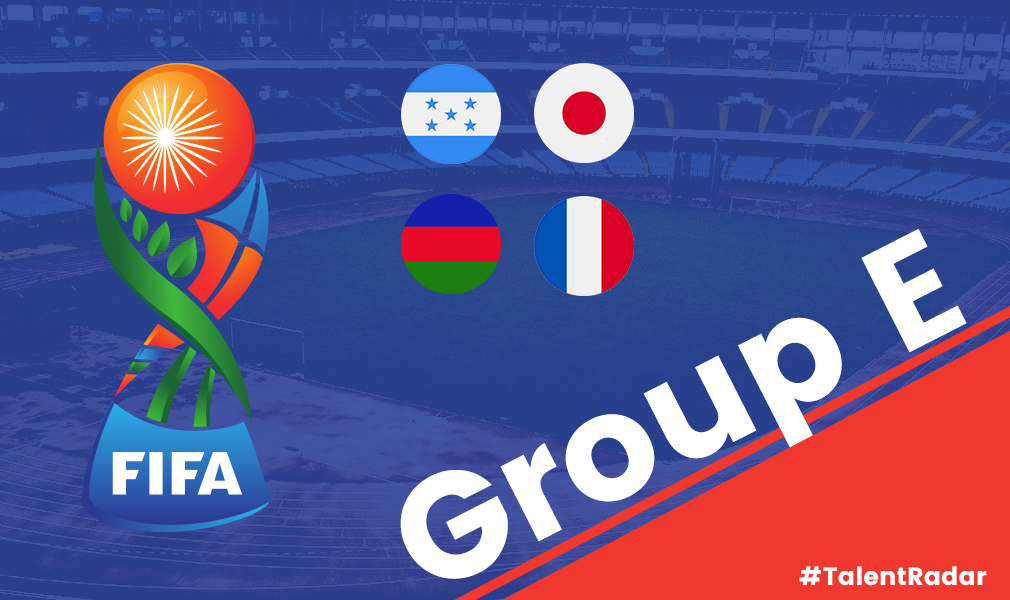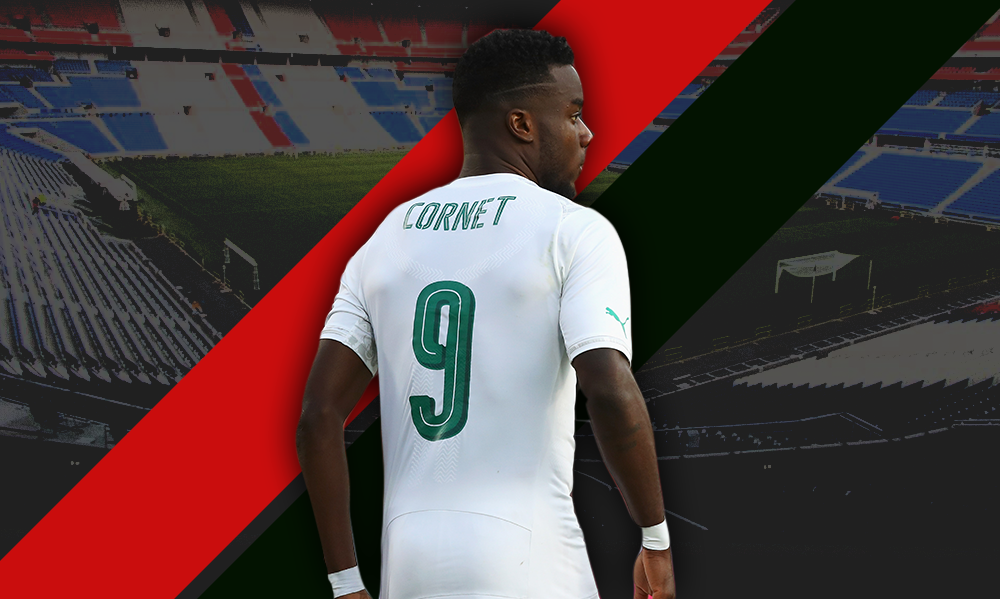At the end of a long football day which saw 4 World Cup matches being played, Japan and Ivory Coast clashed in their respective openers. Colombia, the highest ranked team in the group, had already won their match and picked up 3 points, and the battle between these 2 was seen as crucial to decide which team makes it past the group phase. Both teams boasted of strong line ups, and it was an evenly matched battle.
FORMATION & LINE-UPS
Ivory Coast (4-2-3-1): Barry; Zokora, Bamba, Aurier, Boka (75′ Djakpa) – Tiote, Serey (62′ Drogba) – Kalou, Touré, Gervinho – Bony (78′ Ya)
Japan (4-2-3-1): Kawashima; Morishige, Yoshida, Uchida, Nagatomo – Yamaguchi, Hasebe (54′ Endo) – Okazaki, Honda, Kagawa (86′ Kakitani) – Osako (67′ Okubo)
Scorers: Ivory Coast 2 (Bony 64, Gervinho 66)- Japan 1 (Honda, 16)

Made using Tactical Pad
ANALYSIS
Japan pressing to take early advantage
The ideal pattern of this game would have been Japan keeping possession and Ivory Coast first defending deep and then trying to win the ball to break quickly through Gervinho and Kalou, but this wasn’t exactly the case. Instead, Ivory Coast kept possession but they were quickly closed down by the Japanese side in midfield, with wingers drifting inside (particularly Kagawa interchanging with Honda) and full backs advancing. Japan looked to assert their dominance via their technical players and tried to speed up the game, especially in the attacking third, while Ivory Coast took a more patient approach and calmly passed the ball to try and open a compact Japanese side.
MORE READING
Japan eventually took the lead through terrible defending from Ivory Coast combined with individual brilliance of Honda and then looked more comfortable with their strategy. They didn’t press the Ivorian center backs, but continued to quickly close down the opposition in midfield. They broke through the defense again with some creative play from Honda with Uchida bombing forward from the right. Despite not keeping possession, Kagawa and Honda combined nicely in the central zones, with the latter finding himself with a goalscoring opportunity later on in the first half.
Ivory Coast looked to struggle with breaking down the very compact Japanese side. Japan are a very good team between two boxes, but they quite often fail to assert their dominance into the score sheet, since they lack the goal scoring touch. They defended very well and avoided conceding in the late pressure in the dying minutes of the first half.
Ivory Coast switch to 4-4-2 to turn the game around
Second half started pretty much in the same pattern with Japan pressing higher up in the opening minutes. They managed to force errors again but keeping the high line meant that they were prone to counter attacks, especially with Nagatomo playing so high up the pitch. They had to replace captain Hasebe with Endo due to injury reasons but this was still, a straight swap. On the other hand Sami Lamouchi made an attack minded change and replaced Serey Die with Drogba. Ivory Coast were now a straight 4-4-2, with Drogba and Bony being the striker duo up front. They pressed the Japanese center backs 2 v 2 and with Touré operating from the center, Japan were vulnerable to being overloaded in defense. Eventually Ivory Coast equalized with Bony finishing a wonderful cross from Aurier and a similar scenario repeated itself two minutes after, this time with Gervinho providing the finish to another cross from Aurier.
Substitutions
Now the game’s pattern had become what we expected in the first place. Japan in possession with Ivory Coast defending deep. Zaccheroni immediately replaced Osako with Okubo after the second goal, with the latter playing highest up for Japan, while he had the tendency to drift towards the left with Honda advancing further and Kagawa positioning himself rather left of center. Ivory Coast lost Boka on an injury and Djakpa came in to replace him on another straight swap. Neither of these changes didn’t seem to affect the gameplan that much, while Lamouchi later on replaced Bony with Ya Konan to provide a pair of fresh legs up front and his side looked more 4-4-1-1/4-2-3-1 after this change. Zaccheroni made his last change with a couple of minutes left to go as Kakitani, a proper striker, replaced Kagawa. Ivory Coast were comfortable defending deep, they didn’t look troubled at all and comfortably closed the game to earn very important 3 points.
KEY PLAYER OF THE MATCH
Yaya Touré’s distrubition might have been crucial in both Ivory Coast goals, but one cannot simply leave out Serge Aurier. The right back provided two assists, took advantage of Kagawa staying narrow and not following him on attacks, plus he constantly overlapped to further trouble Nagatomo, whose positioning was way too high up the pitch.
WHERE DOES THIS LEAVE THEM?
This shall be en encouraging start for Ivory Coast. They had adapted a different game plan rather than thought and took up a more positive approach. Of course losing the lead early on is another reason for this, but an attack minded change from Lamouchi tipped the scales in their favor. They will go against Colombia next, who play attacking football and also coming into the match with a win.
Japan’s dominance and brilliance between two boxes didn’t help them secure 3 points from this one. Still, Zaccheroni will stick to what he knows best, as Japan will face Greece, who looked completely unorganized and lost against Colombia. 3 points from that game will keep hope alive for Japan, as it is now a must win situation for them.
This article was written by Firat Aktav. Follow him on Twitter @FiratAktav
Read all our World Cup content here
- Turkish Column: Kartal’s positive changes shadowed by supporter unrest while Ersun Yanal returns - November 14, 2014
- Turkish Column: Fenerbahçe’s tactical battle, Aykut Kocaman returns & more - November 5, 2014
- Turkish football column: Wesley Sneijder’s brilliance, Fatih Terim’s issues & more - October 22, 2014

























































